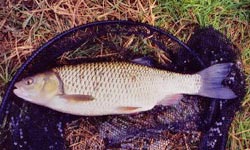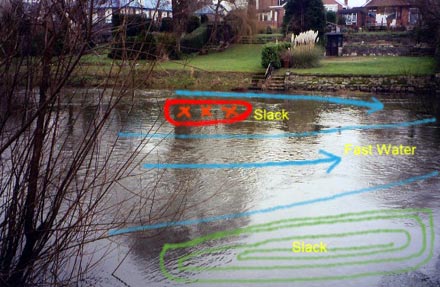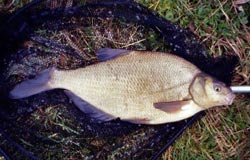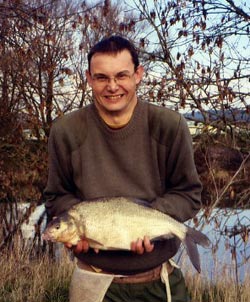| MARK WINTLE |
| Mark Wintle, an angler for thirty-five years, is on a quest to discover and bring to you the magic of fishing. Previously heavily involved with match fishing he now fishes for the sheer fun of it. With an open and enquiring mind, each week Mark will bring to you articles on fishing different rivers, different methods and what makes rivers, and occasionally stillwaters, tick. Add to this a mixed bag of articles on catching big fish, tackle design, angling politics and a few surprises. Are you stuck in a rut fishing the same swim every week? Do you dare to try something different and see a whole new world of angling open up? Yes? Then read Mark Wintle’s regular weekly column. |
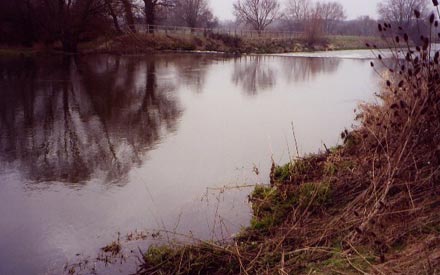  |
| FLAKE AND FLOAT – QUEST FOR A RIVER BREAM After weeks of fishing for roach, chub and grayling this winter, I fancied catching some river bream. There are some good bream in the lower reaches of the Dorset Stour, but it’s a case of praying for the right conditions and then finding the fish. When our trip to the Windrush was called off, the Stour was four feet above normal but a week later, the river was running just a foot up and a lovely greenish clear colour. The weather had settled as well with a dominant high-pressure area covered in cloud, a rare combination for high pressure in February would usually result in clear skies and night frosts. But the cloud kept the frost at bay and the wind had dropped to nothing; conditions, for once, were perfect. I reckoned that attacking some likely swims with trotted bread flake might produce some bream or at worst a decent chub or two. Chub above the weir For bait, I took plenty of bread, 5lb of brown crumb groundbait, and two pints of maggots in case it all went wrong. I planned to end up fishing on the tidal part with maggots to see if I could get some roach but that would have to wait until the end of the day. The bird chorus was deafening as I walked through the woods before reaching the river and began the long trek upstream; hardly surprising for it was St Valentine’s Day when the birds are supposed to pair up!
The swim is a steady glide down to the weir around six feet deep. I tackled up a match rod, small fixed-spool reel loaded with 2 1/2 lb line with a goose quill Avon taking around 5AAA as bulk plus some smaller shots as droppers. The hook was a size 12 Kamasan B611; a strong yet fine wire hook. I mixed up some groundbait, having first mashed up several slices of bread. The mashed bread would break away from the groundbait to hopefully entice the fish. For once, I had forsaken my beloved bread punches and decided to fish with flake. This is a bit more fiddly than punch. It is vital to only pinch the bread a tiny bit on the shank of the hook and not the main part of the bread; to do so results in a solid lump of bread. I began trotting just this side of middle, about ten yards out. The current was pacy but smooth. Upstream, I could see the remnants of extensive reed beds that fill this stretch in summer. Every third cast or so I introduced a ball of groundbait about the size of a golf ball. It took three or four casts to get the depth right with the bait dragging the bottom. The first bite was not that long in coming, and after a short spirited fight, a chunky chub of about two and a half pounds came to the net. Fifteen minutes later, his bigger brother took the bait, and despite trying to get into the snags along the nearside bank, was quickly subdued. At 3.12, it’s a decent sized fish in sparkling condition. After this flying start, the only action I got is a small chub of eight ounces and a dace of about six ounces. It was time for a move upstream to see if I could find a bream. A slice of local angling history
The bream swim is a slack around twenty-five yards from the bank in mid river. (See Picture). The far bank and near bank sides have very fast currents so that to fish it you need to make a long cast with heavy float tackle then hold the line out the water. Feeder fishing does not seem to work. The first time I fished it I got two bream plus chub for 14lbs (3rd), the second I made no mistake with 11 for 48lbs. After that, I fished it again but never got more than five bream. A couple of years later (1989) changes were made to the weir downstream, dropping the level and altering the flow in the bream swim. With the swim changed, the bream moved and the swim became overgrown as a self-set willow grew up in the fishing position. But a few years later the weir was raised again and the bream returned. Those years of neglect had allowed the willows to drastically reduce the bank space. In perfect conditions, hampered by the trees, the question was – would I be able to cast and fish the swim anymore? I was convinced that bream would be present, and although the water was little on the clear side, I ought to get one or two. A brace of bream
Ten minutes later, I hooked a bream only for it to come adrift in the powerful current. At least there were fish present and feeding. Three casts later, I hooked another bream. I had tightened the clutch on my reel for there was little point letting these fish go in such a strong current. It was a case of pulling hard with the rod tip underwater. This brought another difficulty, as it was difficult to judge how much pressure I was exerting on the fish as the current was pushing the rod as well. But after less than a minute, steady winding brought the float into view in the tiny slack by my feet. I netted it, a fine bream of 5.2, with a missing top tail lobe (otter damage?). Ten minutes later, I got his brother at 5.6 (both were males with the beginnings of spawning tubercles on their heads). I fished on for an hour but no more bites came. It had been hard work for a facing Northerly breeze had sprung up, and this tended to move the float out of the slack. I had noted a couple of promising glides downstream as I’d walked up so I packed up and moved to the first of these. Yet another bream
The troublesome breeze had dropped away so I had no problem trotting down the middle with double maggot on the hook. I fed twenty maggots every cast and my first fish was my first ever Stour salmon parr! After this, I found a couple of lively 10oz chub, and eventually some net roach to a pound to round off a glorious day on the river. Although I didn’t end up with any great number of fish, I caught good fish from the four very different swims that I tried, and a total bag in the region of 26lbs. I was pleased to get bream from the Stour. The tidal reaches hold even more, and here and there are some very big bream including fish to ten pounds. The day’s bonuses were the tremendous activity from the bird life that included the courting rituals of a pair of kingfishers, and the friendly banter on the bank with other anglers, all enjoying as fine a day out on the riverbank as you could hope for, as well as some excellent sport. I was fishing part of the Throop fishery, available as part of membership of Ringwood DAA, or day tickets from Bournemouth Fishing Lodge. Wimborne Road, Moordown, 01202 514345. Next week: ‘ Are Dace an Endangered Species?’ |










